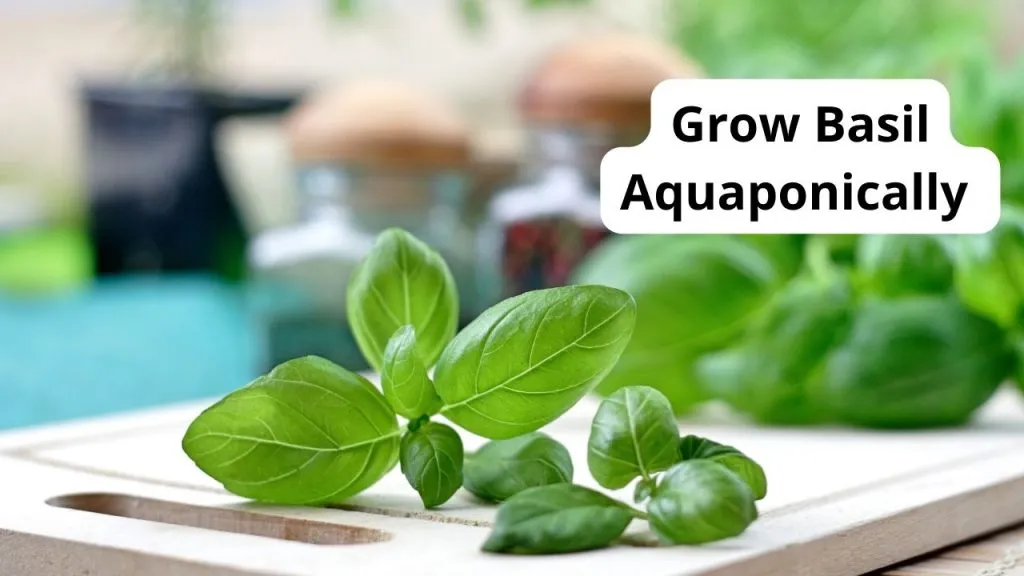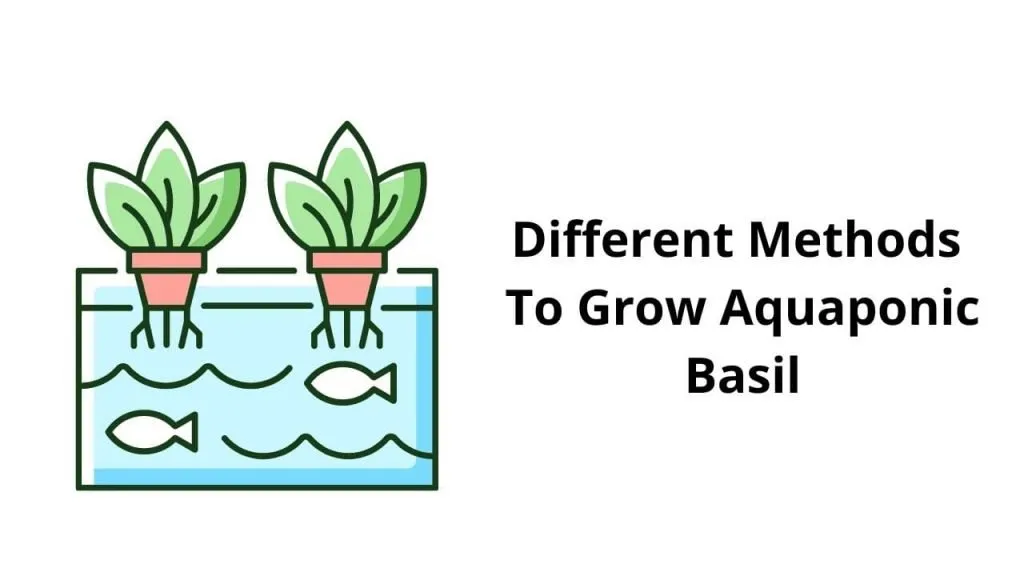Do you want to know How To Grow Aquaponics Basil? Read this Article.
If you are not planting Basil in your garden and buying it from the market, I bet your pesto or pizza is not going to taste as great as it is going to from Aquaponic basil from your garden.
Basil raises well in aquaponics systems because of the perfect growing conditions: warm water, power boost nutrients from fish feces, and sunlight.
Thus it is essential to learn how to grow Aquaponics Basil to get this high-value crop quickly from our garden.
Why Is Basil Essential For Our Health?
Originally cultivated in Asia and Africa, basil is grown worldwide due to its health and religious benefits.
It is considered a sacred and noble herb, and its name means King in the Ancient Greek language.
It is an essential source of Vitamin A and K and macronutrients like Calcium, Iron, and Manganese.
Its antioxidant and anti-inflammatory properties reduce stress and anxiety, improve sugar levels, and reduce the risk of heart diseases and cancer.
It can even use fresh and dry (harvest basil to increase shelf life) both ways.
Why Is Basil Essential For Our Kitchen?
It is mainly incorporated in dishes containing sweet and sour flavors to balance their taste.
It is mainly used with family members’ of thyme, oregano, rosemary, and sage to enhance the dishes’ aroma, color, and flavor.
It is primarily used in recipes like peso, pizza, spaghetti, lasagna, sauces, soups, and many fried chicken recipes to give them distinct flavor and a pleasant aroma.
Its seeds are very popular in Asia for making beverages.
Are We Growing Enough Basil?
Since ancient times people have been harvesting basil for its oil and leaves to cure diseases like vomiting, indigestion, inflammation within nasal passages, snake bites, and the flu.
It is an annual leafy plant most suitable to grow in warm countries with bright sunlight with wide varieties like
- Sweet Basil,
- Holy Basil,
- Lemon Basil,
- Indian Basil,
- Thai Basil,
- Purple Basil, etc.
It is grown worldwide, specifically in countries having the Mediterranean Climate, Subtropical climate, and in temperate zones.
Why We Should Choose Aquaponics To Grow Basil:
Like other greens, lettuce, spinach, and cabbage, basil works well with Aquaponics under optimum conditions.
It’s effortless, fast, and efficient to grow basil using Aquaponics, making it a popular option for first-time growers, commercial growers of basil, and even as a hobby to grow basil.
Farming of Aquaponics Basil

Like other plants, spinach, tomatoes, broccoli, and cucumber are successfully grown in Aquaponics; the farming process of Aquaponics basil consists of three stages:
- Germination
- Transplantation
- Maintenance of plant, fish, and system
Optimum Condition to Grow Aquaponics Basil
Varieties of Basil Suitable for Aquaponics
| Sweet Basil |
| Thai Basil |
| Lemon Basil |
| Spicy Basil |
| Cinnamon basil |
| Holy Basil |
| Genovese basil |
| Purple Basil |
| Greek Basil |
| Cardinal basil |
| African Blue basil |
| Christmas basil |
Fishes Suitable for Aquaponics:
| Nile tilapia |
| Goldfish |
| Koi |
| Cardinal tetras |
| Barramundi |
| Trout |
| Carp |
| Catfish |
| Perch |
| Angelfish |
How to Start Germination for Aquaponics Basil?
It is suggested to plant fresh seeds in a specific growing medium like Rockwool cube or grow sponge or coco coir as per your method or seed requirements.
Begin with a small grow bed and place your seeds half cm deep into the selected growing medium.
Supply water into your grow bed for around a half-hour each day with temperatures between 20 to 25◦C for ideal growth.
It will take a week to germinate under these specific conditions.
Methods for Aquaponics Basil Farming:

By Using a Floating Raft
In this method, basil seeds are planted in grow sponge along with a net pot.
- The net pot is then placed in the rafts where the roots will access the nutrient-rich oxygenated water, and due to this root system will grow quickly.
- Nutrient-rich water will come from the fish tank after passing a physical filter to remove solid waste rather than a biological filter where nitrification will occur.
- After germination, they are transferred into net cups and planted into the rafts to float over canals.
- The water then recirculates after passing physical and biological filters to the fish tank.
- After harvesting, the rafts are cleaned and dried to avoid killing the nitrifying bacteria present on the surface of the raft.
- Advantage: It is best for commercial basil farming.
- Disadvantage: Costly and challenging for beginners.
By Using Media Bed
This technique includes planting basil seedlings in a grow bed system. The plant roots in grow bed gets direct access to the nutrient water.
The roots themselves filter and clean the water before returning to the fish tank for the fish to live.
Media mainly used as growing beds are expanded clay pebbles, gravels, and lava rocks. Bell siphon and pump simultaneously while transporting water between the fish tank and grow bed.
- Advantage: Easy for beginners to grow basil quickly.
- Disadvantage: Its costs increase when large media bed setups are used.
By Using Nutrient Film Technique
In this technique, basil is cultivated in grow pipes in which holes are made according to the net cup size where seedlings are planted.
Grow media clay pebbles, tiny lava rocks, or gravel can be placed around the seedlings in net cups.
Water is pumped through the mechanical filter into the bio-filter and sump tank.
That water then divides half into the fish tank from the sump tank and half through the NFT channel or grow pipes where the plants are planted.
After exiting the grow pipes, the water is recycled to the filters and finally into the fish tank. This process repeats in the cycles.
- Advantage: Basil roots are highly oxygenated in this method for rapid growth.
- Disadvantage: In case of pump failure, the basil yield will begin wilting.
Benefits of Aquaponics Basil farming
1. Harvesting Period is Short:
Basil works efficiently with Aquaponics due to abundant water, nutrients, and sunlight. It usually grows within five to six weeks.
2. Better Nutrient Value:
Basil grown using Aquaponics was more nutritious due to more vitamin A, Vitamin K, Calcium, Iron, and Manganese.
3. Increase in Fish Production:
With proper checking and maintenance of fish, fish production is also increased by Aquaponics due to its perfect ecosystem chain of plants, microbes, and fishes providing nutrients to each other.
4. Decrease in Cost:
It is efficient as you can grow fish and basil side by side in the same area, reducing the cost of expensive nutrients, extra space, soil, and water wastage.
5. Production of Basil Throughout the Year:
A unique feature of regulating temperatures of the Aquaponic system during different weather throughout the year, aquaponics farmers depend less on weather and keep up harvesting basil throughout the year.
6. Minor Planet’s Carbon Footprint:
Basil harvested using Aquaponics can be grown anywhere, whether a rocky place or a barren place.
Its sustainable and environment-friendly technique reduces carbon footprint by increasing its chances of growth worldwide.
How to Grow Aquaponics Basil FAQS
Q: How Effective Is Aquaponics For Farming Basil?
Like other green leafy vegetables and herbs, it is adapted very well to this method due to the presence of sufficient water and Sunlight.
Q: What Are The Most Common Weather Issues While Farming Aquaponics Basil?
There is always a risk of rain, wind, and snow, which can disturb fish and basil growth.
Q: Why Is The Maintenance Of Fish Important In Aquaponics Basil Farming?
Fish provides nutrients for the plant in Aquaponics basil farming like fertilizers; thus, in case of their shortage or death, crops will not grow properly.
Q: When Can We Harvest Aquaponics Basil?
Depending on its seed type, it will take five to six weeks to harvest Aquaponics Basil.
Q: Which Fish Works Best For Farming Aquaponics Basil?
It can work with any fish that can survive around temperatures 18 to 30 ◦C, but most commonly, Tilapia is used worldwide due to its low cost and maintenance.
Q: What Problems Could Be Encountered In An Aquaponics System?
The growth of algae is a common problem in Aquaponics which can block pumps and chock the system.
It also produces an unpleasant smell and a shortage of oxygen in basil plants.
Q: Which Factors Need To Be Monitored While Farming Aquaponics Basil?
Monitor the pH value using pH meters, temperature through digital thermometers, and dissolved oxygen and conductivity through their sensors.
Q: Does Aquaponics Basil Farming Need Sunlight?
The fish tank does not need Sunlight and can be kept in the shade, but Basil Plant needs 14 to 18 hours of sunlight daily.
Q: Does Aquaponics Basil Regrow After Cutting?
Yes, removes its leaves and keep the stem in a growing medium like Rockwool cube or grow sponge or coco coir as per your method to germinate.
Then again, please keep it in your chosen Aquaponics system.
Final Thoughts:
Basil is rightly said to the Kings of Herb due to its culinary and medicinal use.
It is used in dried form, fresh form, its oil is extracted to use, and even its seeds are popularly used worldwide.
So we must know how to grow Aquaponics Basil to economically grow, use and sell it from our garden or field.

My name is Olivia, and I live in the United States and love having plants in my garden. Lots of plants are there on my balcony, indoor and outdoor garden also. Here I am trying to share useful gardening tips, how to grow and care for various plants, etc.
